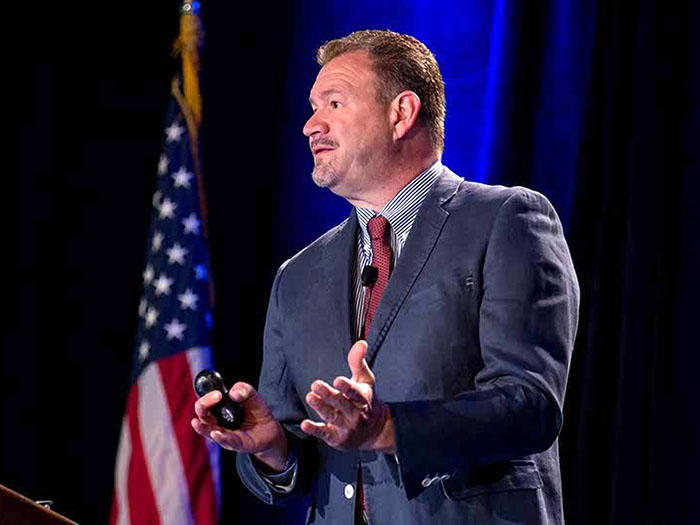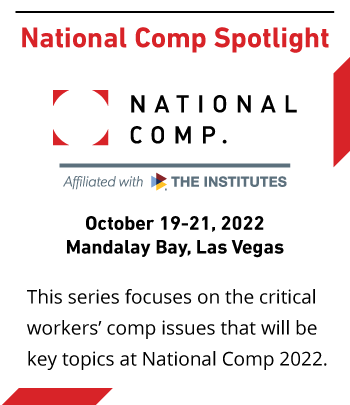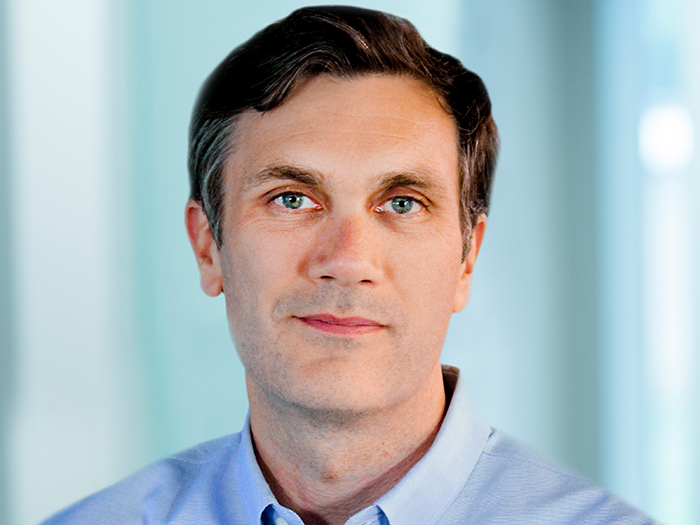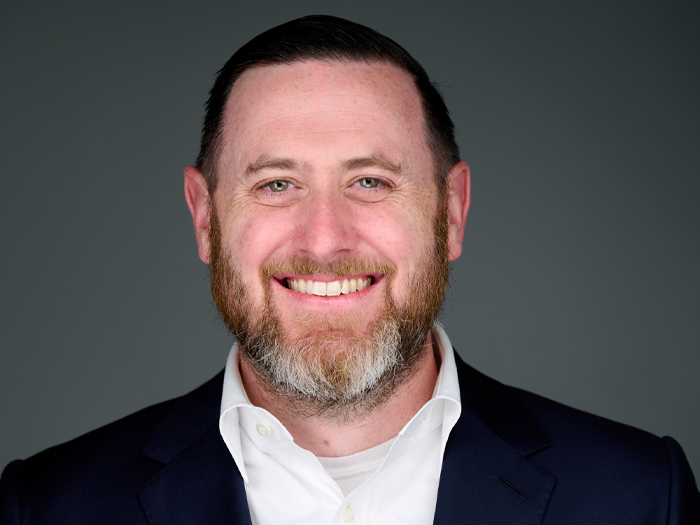National Comp Keynote Casey Chosewood on What’s Next for Worker Safety, Health and Wellbeing

When we look at the “traditional” model of workplace safety and health, programs primarily focus on ensuring a safe work environment, as well as making sure workers are protected from any harm that can arise from the work itself — both extremely important pieces of occupational safety.
But there’s more to the safety puzzle, and Dr. Casey Chosewood has dedicated much of his career to the concept of Total Worker Health® to enhance workplace safety efforts.
 Chosewood, the director of the Office for Total Worker Health at the National Institute for Occupational Safety and Health (NIOSH), a division of the Centers for Disease Control and Prevention, will present the opening keynote at National Comp 2022 in Las Vegas, presenting “Future-casting Workers’ Comp: What’s Next for Worker Safety, Health and Well-being?“ on Oct. 19th.
Chosewood, the director of the Office for Total Worker Health at the National Institute for Occupational Safety and Health (NIOSH), a division of the Centers for Disease Control and Prevention, will present the opening keynote at National Comp 2022 in Las Vegas, presenting “Future-casting Workers’ Comp: What’s Next for Worker Safety, Health and Well-being?“ on Oct. 19th.
Dr. Chosewood spends his days looking at the impact certain factors can have on injury and recovery.
Job-related factors such as wages, hours of work, workload and stress levels, as well as interactions with coworkers and supervisors, access to paid leave and health-promoting workplaces all have an important place for a worker’s wellbeing. Dr. Chosewood uses the Total Worker Health approach to implement best practices and set up guidelines for others to follow.
Chosewood sat down with Risk & Insurance® to discuss in detail some of the primary methods behind Total Worker Health and how he plans to incorporate this vital information into his National Comp 2022 keynote.
Risk & Insurance: Can you start us off by telling us a little bit about yourself? How did you find yourself in the workers’ comp space and what’s led you to the role you have today?
Casey Chosewood: I’ve been a physician for over 30 years, with about 20 of those spent at CDC. I trained as a family medicine physician but have practiced occupational medicine most of my career. My first job at CDC was the medical director of CDC’s three occupational health clinics. Since I’ve been at NIOSH, I’ve led the Total Worker Health program.
Total Worker Health is defined as policies, programs and practices that integrate safety at work with prevention opportunities at work and beyond. It’s all about keeping workers safe but taking the next step to use work and the workplace to make people healthier.
Simply put, organizations must first protect workers and then take a step further by introducing additional policies, programs and practices that advance health on and off the job. The result, if done well, leads to workers with higher levels of wellbeing. This directly benefits workers and by extension, positively impacts the organizations in which they work.
Just as safety culture is critical for industrial settings, a healthy workplace culture is the result of a comprehensive set of steps employers can take to benefit their employees. It’s an ongoing commitment to healthier hiring practices, better job design, attention to working demands and conditions and adequate wages, benefits, recognition and reward.
Good culture supports engagement and retention. It turns a job into a fulfilling experience that provides both a living and a life.
Workers’ comp is a critical part of the occupational safety and health safety net for workers. Timely intervention after injury, comprehensive benefits and resources, and strong supports for return to work and stay-at-work interventions are critical.
R&I: As director of the office of Total Worker Health (TWH) for NIOSH, what are some of your key responsibilities?
CC: Our office is dedicated to the concept of “research to practice.”
Our program activities work to expand and fund research, develop interventions, convene meetings, partnerships and collaborations, and grow the capacity for TWH by fostering training, educational programs, continuing education, degree and certificate programs and symposia.
We also have an internal TWH program for our own employees. We really try to practice what we preach.
“Total Worker Health is defined as policies, programs and practices that integrate safety at work with prevention opportunities at work and beyond. It’s all about keeping workers safe but taking the next step to use work and the workplace to make people healthier.”
All sectors can contain hazards and risks that must be addressed. Implementing a Total Worker Health approach is an ongoing effort in which workers’ safety, health, and wellbeing are top priorities. In many settings, TWH is a constellation of interventions, policy changes and practices that create a robust culture of safety, worker protection and greater health opportunity.
TWH programs should be voluntary and participatory, giving workers a voice in the conditions of their work and a say in workplace offerings.
Putting TWH into action often starts with an organizational focus, looking at the challenges to keeping workers safe and healthy. Changes to policy, the built environment, and programs follow. Enduring, system-wide levers for better health take priority over individual-behavior-change programs.
On our Promising Practices webpage, we highlight real-life examples of organizations that are moving toward such an approach. In addition, scientists both within the Institute and at the NIOSH-funded Centers of Excellence for Total Worker Health are leading a number of research-to-practice initiatives.
R&I: There’s always plenty going on in workers’ compensation. What would you say are today’s most pressing issues that those in the space should be aware of?
CC: Work is rapidly changing. New technologies can increase hazards. Uncertainty is always a risk factor in any industry and in any setting.
That is why the basics of risk identification, even with novel risks, is critical.
We also should pay more attention to psychosocial risk factors, like work-related stress.
Mental health outcomes and worker wellbeing outcomes are directly related to working conditions, supervisory support, job insecurity and overall health care utilization. Work injury risks increase when psychosocial supports are low or working conditions and culture are not supported by health and safety policies.
R&I: How has the pandemic exacerbated these risks for the comp space?
CC: The pandemic created lots of uncertainty and rapid change. Lay-offs early on for some were common, while others worked longer and harder than ever before.
Job loss or insecurity in work breeds many challenges. We’ve seen substance use increase; the risks for substance use disorders among some industries and occupations is alarming. Mental health conditions have also surfaced. Caregiving needs have shifted.
All these have work implications.
How we work, the isolation for some, remote work (with its advantages and disadvantages) has impacted many.
Employers must frequently assess the health and wellbeing of their workforce, be responsive with interventions and support when necessary, and constantly adapt to an ever-changing set of demands and circumstances.
R&I: Where does Total Worker Health fit into the mix when looking at the risks workers’ comp faces and the impact the pandemic has had?
CC: The field should expect changes in what is compensable, especially around the mental health-front and work-associated stress. The trends favor more compensability in this space.
Workplace stress is an extremely important issue in almost all workplaces. It’s one of the most common concerns we hear about from employers.
And today, it’s even more critical that we change this misconception that this discussion doesn’t belong in the workplace, because mental health challenges and the opioid overdose and suicide epidemics are devastating many in our workforce. Some occupations and industries, like construction, mining and transportation, are especially hard hit.
Mental health conditions are a leading cause of disability and are costly for many employers. And underlying mental health concerns or diagnoses impact productivity day in/out and can often slow return-to-work after workers face other injury and illness, whether work related or not.
The quality of the job and the demands of the work are critical to consider here, not just personal risk factors. We know that fast-paced work, high job demands, job insecurity and low wages in many work settings may increase risks for poor mental health outcomes.
Safety pros and HR professionals should increase their comfort around these issues and be ready to help.
Many already have skills to help mitigate or address other challenges workers face. And this should be no different. Most have an understanding of work’s connection to health but broadening this is helpful.
Additional skills around empathy, increased awareness, lessening stigma and providing supportive environments, “soft management” and better people skills can all contribute to a better workplace for all workers, especially those with mental health concerns or with those healing from work injury or illness.
R&I: What are some of the benefits of having a Total Worker Health approach?
CC: TWH when done right shows your team that you care about them — as whole people, on and off the job.
They are not just widgets, but living, breathing, feeling individuals with their own unique skills, challenges and needs.
Those companies that value workers as part of the “work family” have a head start here.
Listen, get input frequently, use the participatory approach, keep an open door and an open mind, give your supervisors more skills and more autonomy, reduce low-value, unnecessary bureaucracies on the job, and recognize and reward more consistently.
R&I: What can comp professionals do to better incorporate Total Worker Health into their practices?
CC: First, get to know the needs of your workforce and make the safety and health of the worker, as an individual, the centerpiece of your efforts.
As you craft your policies and programs, get employee input at every step of the way. Find out the challenges of their work, the bottlenecks, the stressors, and the risks as they see them.
A participatory approach is essential. Find out what programs and interventions are most important to them. Be mindful of the work conditions themselves. Are they causing or contributing to worker safety and health concerns? Addressing these two components not only boosts the relevance of your programs to the workers they are meant to serve, it creates critical buy-in.
In general, offer greater flexibility wherever possible. Offering workers control over how and when work is performed may help prevent and manage job-related stress. The more flexibility that can be built into work design, workflow and schedules, the better individual and organizational health outcomes are likely to be.
Aligning communication between senior leaders and the rest of the organization is also imperative.
An integrated focus on safety and health can’t stop at the boardroom or at the safety office or the employee health clinic; it must permeate throughout the organization in a coordinated way.
Frontline supervisors are a critical part of the puzzle. They must understand the link between work, other risks and safety and health outcomes. This takes an investment in training and mentoring these individuals if we want to optimize wellbeing.
R&I: You’ll be speaking at National Comp this year as the conference keynote. Can you give us a taste of some of what attendees can expect from your talk?
CC: I plan to forecast tomorrow’s workplace, what it will look like and how we will navigate it.
What headwinds lie ahead for us in OSH and the workers’ comp space. What old hazards will remain; what new ones will emerge.
We will talk a lot about new forms of work stress, how futuristic work arrangements will impact worker engagement. We will also examine how the best organizations are preparing for the future.
Your company needs to be leading in this regard, not lagging. This talk will help you lead decisively.
R&I: What is a project you’ve worked on, either professionally or even personally, that you are most proud of and why?
CC: I really love our Future of Work efforts at NIOSH. This is our effort to be proactive to the needs of workers now and for decades to come, anticipating what work will look like for our selves and our kids and grandkids. As a grandparent, that matters a lot to me.
A few concerns: Work is changing rapidly; employment arrangements are shifting. Uncertainty and insecure employment for many will be a constant headwind. New technologies in the workplace have the capability to help or harm workers. So, it is critical for workers, critical end-users of any new tech, to be at the table when these decisions are made.
But lots of hope for the future of work: At NIOSH, we believe work can be and should be more than just a paycheck, more than just a job. The right kind of work, designed with health and wellbeing in mind, offers adequate wages, but it also provides for social connections, for life-long learning and for meaningful contribution to the company and society.
Companies that want a competitive edge should grow their culture, day in and day out, focused on improving the health and wellbeing of their workers. &
Hear more from Dr. Chosewood and other workers’ comp industry leaders at National Comp 2022 at Mandalay Bay in Las Vegas, Oct. 19-21.










